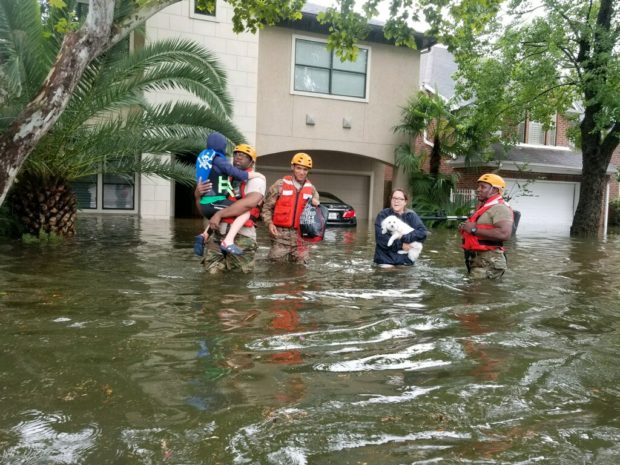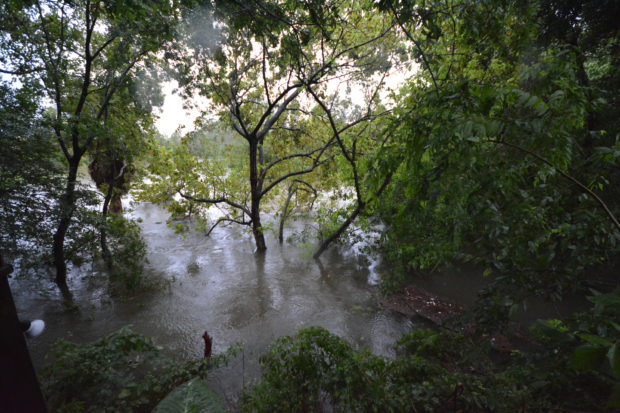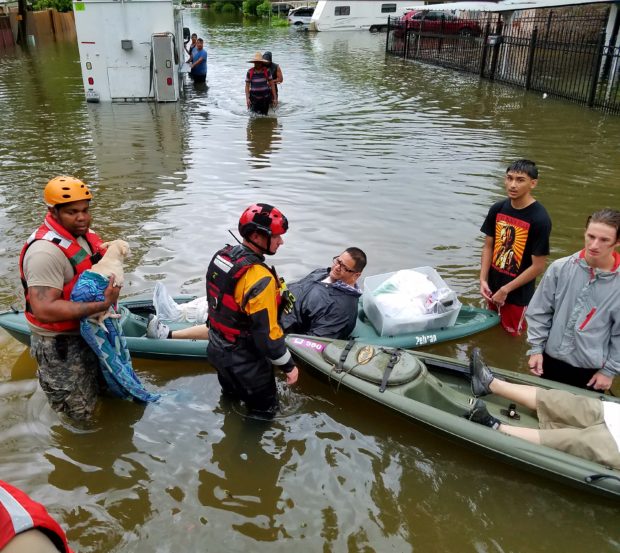We have much more to do and your continued support is needed now more than ever.
Hurricane Harvey: How To Help & Wildlife Impacts to Watch For

For those of us outside the Houston area, watching the coverage of Hurricane Harvey has been both heartbreaking and heartening. It’s devastating to see residents forced from their homes, clutching children and pets, leaving everything else behind. But it’s been amazing to see Texans rise to the challenge, putting every available boat into service – even jet skis and tractors – to rescue neighbors and deliver them to shelter.
It can be a helpless feeling to watch from home, but there are ways we can help right now. You can donate to the American Red Cross online or text HARVEY to 90999 to donate $10. To help lost pets and injured wildlife, you can give to TWRC Wildlife Center, Houston Pets Alive or the Houston Humane Society.

Wildlife Impacts
To state the obvious, wildlife can’t heed hurricane warnings. Even birds that have the ability to fly away may not know which way to flee. As we documented in Hurricane Irene’s wake in 2011, wildlife can be harmed by hurricanes in a number of ways, seeing their habitats destroyed, being stripped of food sources, or being blown far off course.
Wildlife rehabilitators are bracing for a flood of injured animals and there are already early reports of how Hurricane Harvey has impacted wildlife. As alligators, rattlesnakes and deer seek higher ground, some are encountering people (though there are also some hoaxes going viral). An injured, exhausted and desperate hawk took refuge in a taxicab. A reporter spotted fire ants banding together to float out the storm. This woman grabbed her net and rescued bats trapped under a bridge by rising water:
Alicia Plunkett is saving bats from drowning in Houston, as water reaches the top of bridges pic.twitter.com/wHnrbN3Sy8
— Jason Allen (@CBS11JasonAllen) August 27, 2017
Perhaps unexpectedly, fish and wildlife agency staff were among the first to get the call to help and folks from around the Gulf Coast have been racing toward Texas. Their flat-bottomed boats that normally guide them gently over swamps and bayous are ready-made for rescuing people from flooded neighborhoods. Louisiana sportsmen known as the “Cajun Navy” have also generously donated their boats and their time to make rescues.
What to Watch For
Unfortunately, the forecast remains bleak for the next several days as Harvey is expected to remain over the Gulf Coast dumping rain on already-flooded areas for several more days.
Even after Harvey passes, its ripple effects will continue to become evident:
- Industrial facilities and wastewater plants are likely to be overwhelmed and discharge pollution into local waterways
- The extreme flood waters could create a boom for mosquitoes and all the illnesses they carry (an example of how our warming climate is a great for pests)
- Homes and businesses that survive the storm intact may still have to fend off the threat of mold
- Harvey is likely to make for yet another bleak year for Texas oysters, which have been devastated by a series of floods
Houston has been hammered repeatedly in recent years by major floods like those wrought by Harvey. As ProPublica has documented, local officials have relied more on hard, man-made infrastructure and paved over natural defenses like wetlands and prairie grasses. Harvey may force a re-examination of that strategy.

The Road Ahead
Once the storm has moved on, it will be up to policymakers to help support cleanup and rebuilding efforts. Even before Harvey, there were questions about whether agencies like the Army Corps of Engineers had learned the lessons of past storms like Katrina. “Storms are natural events, but floods are usually manmade disasters. That’s because flood damage depends not only on how much water is involved, but on how many people and structures are in its path and how prior human intervention had affected that path,” writes Michael Grunwald in Politico.
“Five years ago, I lived through Superstorm Sandy and we vowed that we would make sure no other communities had to suffer in the same ways by making resiliency a national priority. Yet we are watching heartbreaking suffering by the residents of Houston and the Gulf coast because we as a nation have failed to act,” says Collin O’Mara, the National Wildlife Federation’s president and CEO. “For the safety of our communities, we must invest in risk reduction and natural defenses, and find the political courage to adopt policies from removing incentives for developing flood-prone areas to acting on climate. We must act.”
Congress will likely be asked to pass a bill to provide direct funds as it did after superstorm Sandy, a bill that the National Wildlife Federation worked hard to pass. We pushed to make sure rebuilding was done to maximize reliance on nature-based “green infrastructure” solutions that protect both communities and wildlife from storms and floods being worsened by global warming.

The National Flood Insurance Program, already struggling, is also sure to be newly stressed by Harvey. So far, Congress has tried to bail out the boat of the financially-strapped program rather than plugging its leaks. The National Wildlife Federation has been pushing for real reform to better protect communities and homeowners. Once the storm has passed, Congress will need to take a fresh look at how to fix the NFIP.
We’ll also have to reckon with the fact that yet another American city has been devastated by a storm worsened by climate change. Climate scientists have been warning for a very long time now that warming ocean waters add fuel to storms like Katrina, Sandy, and now Harvey. The National Wildlife Federation has worked to help policymakers connect the dots between climate change and extreme weather. But when it comes to dealing with climate pollution and helping communities adapt to changes already happening, our federal government has responded in fits and starts, at best.
The National Wildlife Federation’s South Central Regional Center is located in Austin, which has seen steady rain but has avoided the brunt of the storm. Our staff there will be monitoring Harvey’s impact on people and wildlife in the coming days and will continue working with our many partners and friends along the coast to assist in the recovery from this catastrophic event.





















